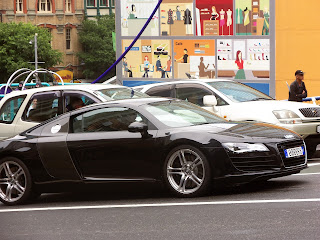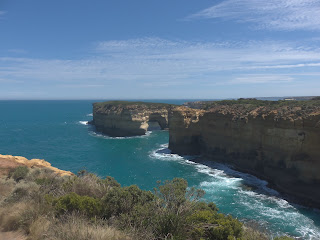Annie loves airports, I love subway systems, Ben loves exotic cars and Marley loves Facebook. We've gotten plenty of airport action so far on this trip, just a bit of mass transit, exotic cars in Los Angeles, Sydney, Brisbane and Singapore, and Facebook when we’ve had internet, which has been sporadic.
The very first airport we flew through on this trip was one of our favorites. Detroit has some futuristic architecture and a ceiling over their people movers that changes colors. The airport at Savusavu in Fiji was the most primitive one we’ve ever seen: just a landing strip and a small cinder-block building.
The one in Lambasa in Fiji was just a little bit bigger, with a seating area and a place that sold snacks and soft drinks.
The Auckland Airport was very efficient, as getting through customs was a breeze. That process in Melbourne was more like mid-summer in Central Florida when there is no breeze and the humidity makes your sweat sweat. For whatever reason it took more than an hour to get through customs there, maybe because the Australian Open was going on.
The best part of the Brisbane Airport was the airline we were flying on to Singapore: Etihad. Our love for Australia made parting truly sweet sorrow as we boarded our flight for the nearly eight-hour long journey to Singapore.
Once on board, our sorrow started to subside as we enjoyed first-class service back in economy class. The flight attendants were very kind and friendly, and, we were informed by a PA announcement, fluent in just about every language you would want to be fluent in.
Australia became even more of a distant memory once we got into the free on-flight entertainment system, called the Ebox. It features all kinds of things to do to pass the time on a long flight, including games, TV shows, and movies. It also provided some entertainment during the pre-flight instructions on how to use an oxygen mask.
That individual is clearly not happy about the oxygen masks dropping down in flight. Fortunately for us, that scenario never played out as we took off, and headed north and west some 3300 nautical miles from Brisbane to Singapore. All four of us settled in, and flipped through the menu to choose our entertainment for the flight.
Annie and I both separately watched Ides of March, the George Clooney movie shot last year mostly in and around Cincinnati. I was a bit worried that the scenes of the Queen City would make me homesick, but I actually enjoyed seeing shots of our hometown. Plus, it helped make a long flight pass fairly quickly. Unlike our experience in Melbourne, getting through customs in Singapore took about ten minutes. We had heard great things about the MRT subway system, but were unsure of the logistics of getting where we needed to go on it, so we grabbed a cab and headed to our hotel, leaving the subway for later in our five-night stay in Singapore.
Finding a hotel in Singapore that could accommodate a family of a four in a location that was friendly to the MRT at a decent price was a bit of a challenge. I settled on the Hotel Royal, which boasted of a “family room” big enough for four people. When we checked in, we found a decent-sized room, equipped with a queen-sized bed and a single. And a lot of floor space. So, I went back down to the front desk and talked to the woman who checked us in. I asked if there was some other sleeping arrangement they had that would truly accommodate four people. She looked at me with a big smile and said quite cheerfully that, no, there was nothing she could do. Sure, we could get a rollaway for $50 a night. I quickly declined that option and headed back up to the room to report my findings to Annie and the kids.
Waking up the next morning, I carefully stepped over my son, still sleeping on the floor, to make some coffee for Annie and me. Early on in our trip, Ben established his fondness for floor sleeping, even when not one, but two beds were an option. When we were in Napier, New Zealand, I found a very affordable cottage, whose owner was willing at my request to give us a fourth night for free for booking three nights. It had three bedrooms, giving Marley and Ben their own bedrooms, which has rarely happened on our excursion. In that cottage, the room Ben had contained two single beds. Apparently unable to decide which bed to sleep in, he piled up the comforters and pillows and slept on the floor for our four nights there.
With that precedent established, he was the perfect candidate to spend the night on the floor in our “family room” at the Hotel Royal in Singapore.
One of the most time-consuming aspects of this trip as we go along is spending time at one stop, planning for the next. That reality meant that on our first day in Singapore we had to get to the Vietnamese Embassy and apply for visas, since we had already booked a flight to Hanoi only five days away. Before leaving Brisbane, I had researched the location of the Vietnamese Embassy, and it turned out to not be about 7 kilometers away from our hotel. The easy thing to do would have been to grab a cab and hit the embassy. But we had heard from a friend who works at times in Singapore that the subway system is extremely easy to use and very efficient. The subway stop closest to our hotel was a ten-minute walk away, so we lathered up in sunscreen, and hit the streets of Singapore, braving the sun, just fifty miles or so north of the Equator.
Getting to the Vietnamese embassy meant catching a ride on the North/South or Red Line to the Circle Comething or Yellow line at the Bishan station, and take the Circle Line to the Holland Village station. Once there, we navigated our way on foot on the twenty-minute or so walk to the Embassy. When we got off the train, I noticed that it was about 11:45 am. Having some familiarity with government workers going back to my time in the state capitol of West Virginia in Charleston, I was a bit concerned that we might be arriving at the embassy just in time for a lunch break.
Our stroll toward the small slice of Vietnamese land within Singapore took us past some very impressive large homes, most likely belonging to some highly placed diplomats. During our walk, I noticed a woman scurrying to and fro with some paper in her hand, clearly looking for an address with which she was unfamiliar, and she seemed to be facing some sort of deadline. After a while, she was heading in the same direction as us, and we could see flags flying high above an official-looking building that had a gate blocking the entrance. As Annie and I and the kids approached the complex, figuring it was our goal, the woman went into a full sprint, and when she got to the iron gate at the entrance, she slipped through an entrance and sprinted up the driveway.
When we got to the gate, I pulled out my Iphone to take a picture and noticed the time was 12:04. I then glanced at the gold sign on the marble post to the left, and saw the sign that said: Office Hours: 9am-12 and 2-4. (Typical government hours!) I then saw the words: Visa hours, 9am-12pm. No! That can’t be!! Instead of taking a photo to document another fascinating aspect of our journey, I herded Annie and the kids inside to see if we still had a chance to get our visa processing process processed.
Luckily, the workers inside the embassy didn’t seem in a hurry to get to lunch, and pointed us in the direction of the forms we needed to fill out to get our visas. Annie and I furiously scribbled in the necessary information as quickly as we could and gave them to the workers, who said we would get them back on Thursday. With that, we grabbed some lunch and took the MRT to Chinatown to check out that scene.
I’ve had the chance to experience subways and train systems in several cities, both in the states and in Europe and part of their charm is the grittiness on a variety of levels. Dirt, grime and graffiti are typically just part of the experience. The MRT in Singapore could double as a hospital operating room. The cars are extremely clean, as are the stations themselves.
Of the subways and train systems I’ve been on, only Zurich comes close the to cleanliness of the Singapore system. Passengers move about in a very orderly fashion, and instead of using paper tickets like most subway systems, Singapore uses green cards that passengers recycle in order to get their deposit back. It means no tickets strewn about the cars or station floors. They seem to be on to something.
Singapore has given us, and especially Ben, the chance to see some exotic cars. Our hotel room is facing a fairly busy road, Newton Road, and whenever Ben hears the throaty growl of a powerful engine, he’ll race to the window to see if he can catch a glimpse of the source of that beautiful noise. He’s been rewarded with a few Ferrari sightings, which we’ve also seen on the streets of Singapore. We’ve also seen a Lamborghini in Brisbane,
A Maserati in Sydney,
A Ferrari in Sydney,
And an Audi R8 in Auckland.
We saw several exotic cars on our very first stop on the trip, in Los Angeles back in December. The specter of seeing Ferraris, and Lamborghinis and Bugattis was one of the main reasons we decided to stay in Southern California for a few days before heading to Fiji. Ben was thrilled when we stopped in a few luxury car stores, where the level of patience with our window-shopping varied by location.
We hope to see a few more exotic cars in our last couple of days in Singapore, in part because we don’t expect to have that experience much over the next few weeks as we dive into Vietnam, Cambodia and Thailand.





















































